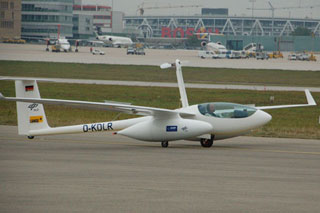Arno's EnergyIdeas (45)
What did the Wright brothers and a hydrogen powered aircraft have in common?
106 years ago, the Wright brothers succeeded with their "Flyer", a "flying box". They achieved the first flight of mankind in an airplane, which was "heavier than air," and controlled by a human hand, powered by an internal combustion engine. This flight on December 17, 1903 lasted a short 12 seconds and covered a distance of 120 ft (36.6 m). On the same day, three other flights were completed, the last one lasted 57 seconds. At the Wright Brothers National Memorial, in the dunes of Kitty Hawk, NC, United States, the scene is impressively reconstructed in 1:1 scale. There you can find also hangars and workshops of the two brothers as well as an instructive information center.

Antares DLR-H2 |
In these days, there was a similar incident in Stuttgart: The record breaking height flight of Antares DLR H2, a modified glider aircraft, supplied by Lange GmbH, equipped with an electric motor for propulsion and launch phase, a fuel cell stack for the chemical energy conversion and hydrogen as secondary energy on board.
My appreciation, combined with hearty congratulations go to the team of
Dr.-Ing. Josef Kallo by the Institute of Technical Thermodynamics, German
Aerospace Center (DLR) in Stuttgart, by whom the entire system integration
and the "airworthiness certification" was done. Other important partners
in this forward-looking program: BASF Fuel Cells and Serenergy from
Denmark.
When, 106 years ago, the Wright brothers pushed their planes at the
evening back into the hangar, they have - just like any of their
contemporaries - certainly not imagined, that they, with their first
flights, so short they were, have raised several branches from the
baptism: The aviation industry, international air traffic, and, combined
with it, the global tourism.
Today, all these three major business segments, not only generate billions
in sales worldwide each and every day, almost in all currencies, but also
create millions of jobs and pleasure, especially the fact that they
connect people quickly and relatively cheaply and, above all, simple,
across borders.
If you compare today, the "Flyer" of the Wright brothers' with a Boeing
747 jumbo jet or even an Airbus A380 from Airbus Industrie, there are
"worlds" between them, from an initial few pounds take-off weight and zero
payload to a present capacity of max. 853 passengers. Singapore Airlines
offers the industry's longest nonstop commercial passenger flight in the
world. This daily flight from Singapore to New York covers a distance of
10.377 miles (16.700 km) and takes about 18 hours.
There was a lot of work between 1903 and today, which one must not
underestimate, for aircraft engineers working in pre-designs and creating
manufacturing documents, with work for structural engineers, work for
material people, work for process engineers and aircraft builders. Work
for designers and logisticians, manual work for specialists, a lot of work
for those who are familiar with sales, service and warranties. And all of
this globally and in principle "around the clock." There are also to
consider the extensive certification requirements in the aircraft (and
also space) industry. Anyone who has ever witnessed an AoG case (aircraft
on ground), know what I'm talking about.
Back to the past, back to the Wright brothers, they also watched the
activities of first "aviator of mankind", the German Otto Lilienthal, he
was their biggest ideal. He succeeded in 1891, the first flight with his
self-constructed flying machine. News spread about this at that time
without e-mail, Facebook, Google and Twitter. Who could have imagined in
his time, which could be achieved from the ridiculous small aircrafts at
that time? Certainly no one. And I’m sure that none of today's
contemporaries can imagine what would result from the technology carrier
Antares DLR H2. Everything can come out of this project.
However, this development will not come by itself. Above all, it will not
come by or with government support, in any form whatsoever. New things,
new services and new features, based on the philosophy of Antares DLR H2
will be created, which today we can not even imagine yet. "... Far beyond
imagination ..." the Americans say in such a case. And here they're
right.
To achieve that goal, many of us will have to work hard. Let all start
with it now, before it's too late and let us all look forward to the time
in 106 years ... more to come ...
Links to the news:
http://www.dlr.de/en/desktopdefault.aspx/tabid-343/5574_read-18278/
https://www.hydrogenambassadors.com/meet-aae/f-cell2009/dlr-antares.php
https://www.hydrogenambassadors.com/meet-aae/wright-brothers/index.php
https://www.hydrogenambassadors.com/background/35-locomotives-could-not-fly-or-evolution-in-the-aircraft-industry-1903-2007.php
|
